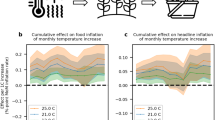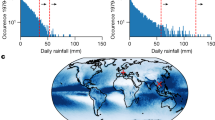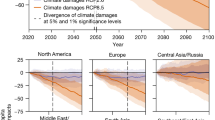Abstract
Elevated annual average temperature has been found to impact macro-economic growth. However, various fundamental elements of the economy are affected by deviations of daily temperature from seasonal expectations which are not well reflected in annual averages. Here we show that increases in seasonally adjusted day-to-day temperature variability reduce macro-economic growth independent of and in addition to changes in annual average temperature. Combining observed day-to-day temperature variability with subnational economic data for 1,537 regions worldwide over 40 years in fixed-effects panel models, we find that an extra degree of variability results in a five percentage-point reduction in regional growth rates on average. The impact of day-to-day variability is modulated by seasonal temperature difference and income, resulting in highest vulnerability in low-latitude, low-income regions (12 percentage-point reduction). These findings illuminate a new, global-impact channel in the climate–economy relationship that demands a more comprehensive assessment in both climate and integrated assessment models.
This is a preview of subscription content, access via your institution
Access options
Access Nature and 54 other Nature Portfolio journals
Get Nature+, our best-value online-access subscription
$29.99 / 30 days
cancel any time
Subscribe to this journal
Receive 12 print issues and online access
$209.00 per year
only $17.42 per issue
Buy this article
- Purchase on Springer Link
- Instant access to full article PDF
Prices may be subject to local taxes which are calculated during checkout




Similar content being viewed by others
Data availability
ERA5 data are publicly available from the European Centre for Medium-Range Weather Forecasts (https://www.ecmwf.int/). The 0.5 × 0.5° resolution version used in this analysis and the EWEMBI and WATCH climate datasets are available from the Inter-Sectoral Impact Model Intercomparison Project (https://www.isimip.org/) or from the corresponding author upon request. Source data are provided with this paper. All other data are publicly available at https://doi.org/10.5281/zenodo.4323163 (ref. 63).
Code availability
All code used for analysis and plotting are publicly available at https://doi.org/10.5281/zenodo.4323163 (ref. 63).
References
Zeebe, R. E., Ridgwell, A. & Zachos, J. C. Anthropogenic carbon release rate unprecedented during the past 66 million years. Nat. Geosci. 9, 325–329 (2016).
Smith, S. J., Edmonds, J., Hartin, C. A., Mundra, A. & Calvin, K. Near-term acceleration in the rate of temperature change. Nat. Clim. Change 5, 333–336 (2015).
Tierney, J. E. et al. Late-twentieth-century warming in Lake Tanganyika unprecedented since AD 500. Nat. Geosci. 3, 422–425 (2010).
D’Andrea, W. J. et al. Mild little ice age and unprecedented recent warmth in an 1800 year lake sediment record from Svalbard. Geology 40, 1007–1010 (2012).
Ribes, A., Zwiers, F. W., Azaïs, J. M. & Naveau, P. A new statistical approach to climate change detection and attribution. Clim. Dyn. 48, 367–386 (2017).
Jones, G. S., Stott, P. A. & Christidis, N. Attribution of observed historical near-surface temperature variations to anthropogenic and natural causes using CMIP5 simulations. J. Geophys. Res. Atmos. 118, 4001–4024 (2013).
Wigley, T. M. L. & Santer, B. D. A probabilistic quantification of the anthropogenic component of twentieth century global warming. Clim. Dyn. 40, 1087–1102 (2013).
Gillett, N. P., Arora, V. K., Flato, G. M., Scinocca, J. F. & von Salzen, K. Improved constraints on 21st-century warming derived using 160 years of temperature observations. Geophys. Res. Lett. 39, L01704 (2012).
IPCC Climate Change 2013: The Physical Science Basis (eds Stocker, T. F. et al.) (Cambridge Univ. Press, 2013).
IPCC Climate Change 2014: Impacts, Adaptation, and Vulnerability (eds Field, C. B. et al.) (Cambridge Univ. Press, 2014).
Dell, M., Jones, B. & Olken, B. What do we learn from the weather? The new climate–economy literature. J. Econ. Lit. 52, 740–798 (2014).
Carleton, T. A. & Hsiang, S. M. Social and economic impacts of climate. Science 353, aad9837 (2016).
Auffhammer, M. Quantifying economic damages from climate change. J. Econ. Perspect. 32, 33–52 (2018).
Kolstad, C. D. & Moore, F. C. Estimating the Economic Impacts of Climate Change Using Weather Observations Working Paper No. 25537 (NBER, 2019).
Martinich, J. & Crimmins, A. Climate damages and adaptation potential across diverse sectors of the United States. Nat. Clim. Change 9, 397–404 (2019).
Moore, F. C. et al. New science of climate change impacts on agriculture implies higher social cost of carbon. Nat. Commun. 8, 1607 (2017).
Hsiang, S. M., Burke, M. & Miguel, E. Quantifying the influence of climate on human conflict. Science 341, 1235367 (2013).
Wenz, L., Levermann, A. & Auffhammer, M. North–south polarization of European electricity consumption under future warming. Proc. Natl Acad. Sci. USA 114, E7910–E7918 (2017).
Auffhammer, M., Baylis, P. & Hausman, C. H. Climate change is projected to have severe impacts on the frequency and intensity of peak electricity demand across the United States. Proc. Natl Acad. Sci. USA 114, 1886–1891 (2017).
Kalkuhl, M. & Sedova, B. Who are the climate migrants and where do they go? Evidence from rural India. World Dev. 129, 104848 (2020).
Burke, M. et al. Higher temperatures increase suicide rates in the United States and Mexico. Nat. Clim. Change 8, 723–729 (2018).
Grinsted, A., Ditlevsen, P. & Christensen, J. H. Normalized US hurricane damage estimates using area of total destruction, 1900–2018. Proc. Natl Acad. Sci. USA 116, 23942–23946 (2019).
Coronese, M., Lamperti, F., Keller, K., Chiaromonte, F. & Roventini, A. Evidence for sharp increase in the economic damages of extreme natural disasters. Proc. Natl Acad. Sci. USA 116, 21450–21455 (2019).
Dell, M., Jones, B. F. & Olken, B. A. Temperature shocks and economic growth: evidence from the last half century. Am. Econ. J. Macroecon. 4, 66–95 (2012).
Burke, M., Hsiang, S. & Miguel, E. Global non-linear effect of temperature on economic production. Nature 527, 235–239 (2015).
Howard, P. & Sterner, T. Few and not so far between: a meta-analysis of climate damage estimates. Environ. Resour. Econ. 68, 197–225 (2017).
Kalkuhl, M. & Wenz, L. The impact of climate conditions on economic production. Evidence from a global panel of regions. J. Environ. Econ. Manage. 103, 102360 (2020).
Burke, M. & Tanutama, V. Climatic Constraints on Aggregate Economic Output Working Paper No. 25779 (NBER, 2019).
Diffenbaugh, N. S. & Burke, M. Global warming has increased global economic inequality. Proc. Natl Acad. Sci. USA 116, 9808–9813 (2019).
Schlenker, W. & Roberts, M. J. Nonlinear temperature effects indicate severe damages to U.S. crop yields under climate change. Proc. Natl Acad. Sci. USA 106, 15594–15598 (2009).
Sudarshan, A. & Tewari, M. The Economic Impacts of Temperature on Industrial Productivity: Evidence from Indian Manufacturing Working Paper No. 278 (ICRIER, 2014).
Ramey, G. & Ramey, V. A. Cross-country evidence on the link between volatility and growth. Am. Econ. Rev. 85, 1138–1151 (1995).
Aghion, P., Bacchetta, P., Rancière, R. & Rogoff, K. Exchange rate volatility and productivity growth: the role of financial development. J. Monet. Econ. 56, 494–513 (2009).
Haile, M. G., Kalkuhl, M. & von Braun, J. Worldwide acreage and yield response to international price change and volatility: a dynamic panel data analysis for wheat, rice, corn, and soybeans. Am. J. Agric. Econ. 98, 172–190 (2015).
Myers, R. J. On the costs of food price fluctuations in low-income countries. Food Policy 31, 288–301 (2006).
Aizenman, J. & Marion, N. Volatility and investment: interpreting evidence from developing countries. Economica 66, 157–1179 (1999).
Fernández-Villaverde, J., Guerrón-Quintana, P., Rubio-Ramírez, J. F. & Uribe, M. Risk matters: the real effects of volatility shocks. Am. Econ. Rev. 101, 2530–2561 (2011).
Borch, K. H. Economics of Insurance (Elsevier, 1990).
Semonov, M. A. & Porter, J. R. Climatic variability and the modelling of crop yields. Agric. For. Meteorol. 73, 265–283 (1995).
Wheeler, T. R. et al. Temperature variability and the yield of annual crops. Agric. Ecosyst. Environ. 8, 159–167 (2000).
Celgar, A. et al. Impact of meteorological drivers on regional inter-annual crop yield variability in France. Agric. For. Meteorol. 216, 58–67 (2016).
Rowhani, P., Lobell, D. B., Linderman, M. & Ramankutty, N. Climate variability and crop production in Tanzania. Agric. For. Meteorol. 151, 449–460 (2011).
Shi, L. et al. Impacts of temperature and its variability on mortality in New England. Nat. Clim. Change 5, 988–991 (2015).
Zanobetti, A., O’Neill, M. S., Gronlund, C. J. & Schwartz, J. D. Temperature variability and long-term survival. Proc. Natl Acad. Sci. USA 109, 6608–6613 (2012).
Bertrand, J. L. & Parnaudeau, M. Ranking the impact of climate variability on UK retail sectors: a path to resilience. SSRN https://ssrn.com/abstract=2675965 (2015).
Makridis, C. Can you feel the heat? Extreme temperatures, stock returns, and economic sentiment. SSRN https://ssrn.com/abstract=3095422 (2018).
Moberg, A. et al. Day‐to‐day temperature variability trends in 160- to 275-year-long European instrumental records. J. Geophys. Res. 105, 22849–22868 (2000).
Nordhaus, W. D. Geography and macroeconomics: new data and new findings. Proc. Natl Acad. Sci. USA 103, 3510–3517 (2006).
van der Ploeg, F. & Poelhekke, S. Volatility and the natural resource curse. Oxf. Econ. Pap. 61, 727–760 (2009).
Dell, M., Jones, B. F. & Olken, B. A. Temperature and income: reconciling new cross-sectional and panel estimates. Am. Econ. Rev. 99, 198–204 (2009).
Moore, F. C. & Diaz, D. B. Temperature impacts on economic growth warrant stringent mitigation policy. Nat. Clim. Change 5, 127–131 (2015).
Ueckerdt, F. et al. The economically optimal warming limit of the planet. Earth Syst. Dyn. 10, 741 (2019).
Glanemann, N., Willner, S. N. & Levermann, A. Paris climate agreement passes the cost–benefit test. Nat. Commun. 11, 110 (2020).
Willner, S. N., Otto, C. & Levermann, A. Global economic response to river floods. Nat. Clim. Change 8, 594–598 (2018).
Barrot, J. N. & Sauvagnat, J. Input specificity and the propagation of idiosyncratic shocks in production networks. Q. J. Econ. 131, 1543–1592 (2016).
ISO 3166 country codes. International Organization for Standardization https://www.iso.org/iso-3166-country-codes.html (2021).
ECMWF Reanalysis v5 (ERA5) (Copernicus Climate Change Service, 2017); https://www.ecmwf.int/en/forecasts/datasets/reanalysis-datasets/era5
Weedon, G. P. et al. The WFDEI meteorological forcing data set: WATCH Forcing Data methodology applied to ERA-Interim reanalysis data. Water Resour. Res. 50, 7505–7514 (2014).
Lange, S. EartH2Observe, WFDEI and ERA-Interim data Merged and Bias-corrected for ISIMIP (EWEMBI) (GFZ Data Services, 2019); https://esg.pik-potsdam.de/search/isimip/
GADM Version 3.6 (Univ. California Davis, accessed 1 October 2019); https://gadm.org
GDP (Current US$) (World Bank, accessed 10 February 2020); https://data.worldbank.org/indicator/NY.GDP.MKTP.CD
Population, Total (World Bank, accessed 2 October 2020); https://data.worldbank.org/indicator/SP.POP.TOTL
Kotz, M. Data and code for the publication ‘Day-to-day temperature variability reduces economic growth’ Version 1 (2020); https://doi.org/10.5281/zenodo.4323163
Acknowledgements
We thank S. Lange for his helpful guidance in accessing and using climate data from the Inter-Sectoral Impact Model Intercomparison Project database. We gratefully acknowledge funding from the Volkswagen Foundation. Economic output data are provided by M. Kalkuhl and his team at the Mercator Research Institute on Global Commons and Climate Change.
Author information
Authors and Affiliations
Contributions
M. Kalkuhl provided the economic data. A.L. proposed the climate measure. M. Kotz processed the climate and economic data. M. Kotz and L.W. designed the regression models. All authors contributed to the interpretation of the results. M. Kotz and L.W. wrote the manuscript, with all authors providing feedback.
Corresponding author
Ethics declarations
Competing interests
The authors declare no competing interests.
Additional information
Peer review information Nature Climate Change thanks Shouro Dasgupta and the other, anonymous, reviewer(s) for their contribution to the peer review of this work.
Publisher’s note Springer Nature remains neutral with regard to jurisdictional claims in published maps and institutional affiliations.
Extended data
Extended Data Fig. 1 Marginal effects of day-to-day temperature variability on regional economic growth rates.
Marginal effects of a 1° Celsius increase of day-to-day temperature variability on regional growth rates, as estimated by model (7) in Table 1. Regions which are accustomed to smaller seasonal temperature differences suffer greater marginal losses (greater negative marginal changes) from a 1 degree increase of day-to-day temperature variability. 95% confidence intervals are shown shaded, and the histograms show the distribution of the data used to estimate the model.
Extended Data Fig. 2 Partitioning of the data by per-capita income.
Partitioning data based on above- and below-median national (a) and regional (b) averages of regional income (GRP) per capita. Data from 2008, the year in which we have best coverage across regions, or the closest year to this for which data are available, are used. Histograms of the distribution of national average (a.i) and regional (b.i) GRP per capita are shown with the median income indicated by a vertical black line. Partitions from (a) are used to estimate the results shown in Fig. 4, those from (b) are used to estimate the results shown in Extend Data Fig. 3.
Extended Data Fig. 3 Marginal effects of high and low-income regions.
Marginal effects of a 1 degree increase of day-to-day temperature variability on regional growth rates, estimated for regions with below- and above-median regional income. When partitioned based on regional-income, the difference between the response of high- and low-income regions is not significant, although above-median income regions generally experience smaller marginal losses. The results shown here are based on the partition shown in Extended Data Fig. 2b and, and the models used to estimate the marginal effects are those shown in Supplementary Table 9.
Supplementary information
Supplementary Information
Supplementary Sections 1–8, Figs. 1–3 and Tables 1–11.
Source data
Source Data Fig. 1
Daily temperature data for the two regions shown in Fig. 1.
Source Data Fig. 3
Data on national population, GDP per capita and marginal effects for Fig. 3.
Source Data Fig. 4
Data of the central marginal effects and upper and lower limits to the marginal effects for above-median-income and below-median-income countries as shown in Fig. 4.
Source Data Extended Data Fig. 1
Data of the central marginal effects and upper and lower limits to the marginal effects shown in Extended Data Fig. 1.
Source Data Extended Data Fig. 3
Data of the central marginal effects and upper and lower limits to the marginal effects for rich and poor regions as shown in Extended Data Fig. 3.
Rights and permissions
About this article
Cite this article
Kotz, M., Wenz, L., Stechemesser, A. et al. Day-to-day temperature variability reduces economic growth. Nat. Clim. Chang. 11, 319–325 (2021). https://doi.org/10.1038/s41558-020-00985-5
Received:
Accepted:
Published:
Issue Date:
DOI: https://doi.org/10.1038/s41558-020-00985-5
This article is cited by
-
The overlooked health impacts of extreme rainfall exposure in 30 East Asian cities
Nature Sustainability (2024)
-
Global warming and heat extremes to enhance inflationary pressures
Communications Earth & Environment (2024)
-
Daily temperature variation in March in East Asia from 1979 to 2020
Climate Dynamics (2024)
-
The Macroeconomic Impact of Global and Country-Specific Climate Risk
Environmental and Resource Economics (2024)
-
How rising temperatures affect electricity consumption and economic development in Mexico
Environment, Development and Sustainability (2024)



